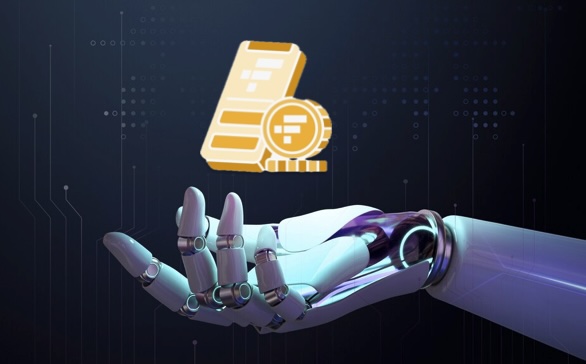
Since the onset of the digital era, radical changes have been witnessed in the management and investment of cryptocurrencies. Most of the exciting developments have been coming in the sector of artificial intelligence (AI), which is making it possible to predict trends within the crypto markets with amazing accuracy. This article presents an insight into the world of the best AI crypto prediction strategies, including their working, significance, and what to expect in the times ahead.
Introduction to AI and Cryptocurrency Prediction
Cryptocurrencies are notoriously volatile. This volatility, while risky, offers potential high returns on investment, making the market attractive to traders. The best AI crypto prediction tools leverage machine learning algorithms to analyze market data and predict future movements.
What is AI Crypto Prediction?
AI crypto prediction involves the utilization of machine learning algorithms to analyze vast amounts of historical market data and make forecasts regarding future cryptocurrency price movements. These algorithms learn from patterns and trends in the data to generate predictions that can guide investment decisions.
Importance of Predictions
The importance of AI-powered predictions in the cryptocurrency market cannot be overstated. Here’s why they are crucial:
- Informed Decision Making: Predictions provide traders and investors with valuable insights that aid in making informed decisions. By analyzing market trends and patterns, AI algorithms can help identify potential opportunities and risks, allowing stakeholders to adjust their strategies accordingly.
- Maximizing Returns: Making accurate predictions can lead to higher returns on investment. By leveraging AI tools to anticipate market movements, traders can capitalize on favorable trends and optimize their trading strategies to maximize profits.
- Minimizing Losses: Predictions also play a critical role in risk management. By identifying potential downturns or market corrections, traders can implement measures to minimize losses and protect their investments.
- Reducing Emotional Bias: Emotions can cloud judgment and lead to irrational decision-making in trading. AI-powered prediction tools operate based on data and algorithms, devoid of emotional biases, thereby providing a more objective analysis of market conditions.
How AI Crypto Prediction Works
AI crypto prediction models use a variety of inputs to forecast market trends. These include historical price data, trading volumes, social media sentiment, and macroeconomic indicators. Let’s delve into the mechanics behind the prediction process:
Data Collection
The foundation of AI crypto prediction lies in the collection of vast amounts of data from diverse sources. This process involves gathering information on:
- Historical Price Data: Records of past cryptocurrency prices, often spanning several years, are collected from various exchanges.
- Trading Volumes: Data on the volume of cryptocurrency traded over time is essential for understanding market activity and liquidity.
- Social Media Sentiment: Analysis of social media platforms, forums, and news articles provides insight into public sentiment towards different cryptocurrencies.
- Macroeconomic Indicators: Factors such as economic reports, regulatory developments, and geopolitical events can influence cryptocurrency prices and are therefore incorporated into the prediction models.
Model Training
Once the data is collected, it is used to train the AI models on recognizing patterns and trends within the cryptocurrency markets. This training process involves:
- Feature Engineering: Identifying relevant features or variables from the collected data that are indicative of future price movements.
- Algorithm Selection: Choosing appropriate machine learning algorithms such as neural networks, support vector machines, or decision trees based on the characteristics of the data.
- Parameter Tuning: Optimizing the parameters of the selected algorithms to improve prediction accuracy and reduce errors.
Prediction Generation
After the AI models are trained, they are applied to current data to generate predictions about future cryptocurrency prices. This prediction generation phase involves:
- Data Preprocessing: Cleaning and transforming raw data to prepare it for input into the trained models.
- Prediction Output: Utilizing the trained AI models to analyze current market conditions and generate forecasts of cryptocurrency prices over various time horizons.
- Risk Assessment: Evaluating the uncertainty and potential risks associated with the generated predictions, considering factors such as volatility and market dynamics.
Types of AI Models Used for Crypto Prediction

Predicting cryptocurrency prices involves leveraging various types of AI models, each designed to excel in specific tasks and scenarios. Understanding these models is crucial for effectively utilizing AI in crypto prediction. Here are several types of AI models commonly used in this domain:
Neural Networks
Neural networks are a class of AI models inspired by the structure and function of the human brain. They consist of interconnected nodes (neurons) arranged in layers, allowing them to learn complex patterns from data. In the context of crypto prediction:
- Strengths: Neural networks are particularly adept at recognizing intricate patterns in large and noisy datasets, making them well-suited for analyzing the complexities of cryptocurrency markets.
- Applications: They are commonly used to forecast cryptocurrency prices by learning from historical price data, trading volumes, and other relevant indicators.
Support Vector Machines (SVM)
Support Vector Machines (SVM) are powerful supervised learning models used for classification and regression tasks. In crypto prediction:
- Strengths: SVMs excel in tasks requiring classification, making them valuable for predicting market directions (e.g., whether prices will rise or fall).
- Applications: They are employed to analyze cryptocurrency market sentiment and make predictions based on factors such as social media activity and news sentiment.
Decision Trees
Decision trees are a simple yet effective type of AI model that organizes data into a hierarchical structure of decision nodes. Each node represents a feature or attribute, and branches represent possible outcomes based on decisions. In the context of crypto prediction:
- Strengths: Decision trees are adept at breaking down complex data by making decisions based on past values, enabling them to identify trends and patterns.
- Applications: They are utilized in analyzing historical price movements, identifying key support and resistance levels, and making predictions about future price movements.
Comparison of AI Models
Here’s a comparison of the strengths and applications of the AI models mentioned:
| Model | Strengths | Applications |
| Neural Networks | Recognizing complex patterns | Forecasting cryptocurrency prices |
| Support Vector Machines (SVM) | Classification tasks, predicting market directions | Analyzing market sentiment, predicting price movements |
| Decision Trees | Breaking down data, identifying trends | Analyzing historical price movements, predicting future prices |
Advantages of Using AI for Crypto Prediction
The best AI crypto prediction models offer numerous advantages that can significantly enhance trading strategies. Benefits include:
Accuracy
One of the foremost advantages of employing AI for crypto prediction is its unparalleled accuracy. AI models excel at processing vast amounts of data, enabling them to identify complex patterns and trends that may elude human traders. By analyzing historical price data, market sentiment, trading volumes, and other relevant indicators, AI algorithms can generate highly accurate predictions regarding future price movements.
| Aspect | Description |
| Data Processing | AI can process large volumes of data, including structured and unstructured data, to identify intricate patterns and correlations. |
| Pattern Recognition | AI algorithms are adept at recognizing subtle patterns in cryptocurrency markets, enabling them to make precise predictions with minimal margin for error. |
| Market Sentiment | By analyzing social media, news articles, and other sources of market sentiment, AI models can gauge investor sentiment and incorporate it into their predictions. |
Moreover, AI-driven models can adapt to evolving market conditions and adjust their predictions accordingly, ensuring that traders stay ahead of the curve. This adaptability is particularly crucial in the highly dynamic and unpredictable world of cryptocurrency trading.
Speed
Another key advantage of AI in crypto prediction is its unparalleled speed. Unlike human traders, who may require significant time to analyze data and make informed decisions, AI algorithms can swiftly process vast amounts of information and execute trades in real-time. This rapid analysis and decision-making capability enable AI-powered trading systems to capitalize on fleeting market opportunities and execute trades with precision.
| Aspect | Description |
| Real-Time | AI algorithms can analyze market data and make predictions in real-time, allowing traders to capitalize on fleeting market opportunities and respond to dynamic price movements. |
| Execution | AI-powered trading systems can execute trades swiftly and efficiently, minimizing latency and ensuring timely execution of buy and sell orders. |
| Decision-Making | With their ability to process data rapidly, AI models can make informed trading decisions within milliseconds, enabling traders to react promptly to changing market conditions. |
Furthermore, AI algorithms can continuously monitor market conditions and adjust trading strategies in real-time, ensuring that trades are executed at optimal moments. This agility is essential in fast-paced markets where even minor delays can result in missed opportunities or losses.
Scalability
Scalability is another significant advantage offered by AI in crypto prediction. Unlike traditional trading strategies that may struggle to accommodate a growing number of cryptocurrencies and data points, AI-powered systems can effortlessly scale to encompass a diverse array of assets and information sources. This scalability enables traders to expand their trading portfolios and adapt to evolving market conditions without sacrificing performance.
| Aspect | Description |
| Asset Coverage | AI models can analyze multiple cryptocurrencies simultaneously, allowing traders to diversify their portfolios and capitalize on opportunities across various digital assets. |
| Data Integration | AI-powered trading systems can integrate data from diverse sources, including cryptocurrency exchanges, social media platforms, and news outlets, to generate comprehensive market analyses. |
| Performance | Despite encompassing a broader range of assets and data points, AI-driven trading systems can maintain high performance levels, ensuring consistent accuracy and speed across various market conditions. |
Moreover, AI algorithms can adapt to changes in market dynamics and incorporate new data sources seamlessly, ensuring that trading strategies remain robust and effective over time. This adaptability is crucial in an ever-evolving market landscape where new cryptocurrencies and market trends emerge regularly.
Real-World Applications

Several companies and platforms have successfully integrated AI crypto prediction into their operations, providing valuable insights to users. Examples include:
Trading Bots
Trading bots are automated systems that utilize AI predictions to execute buy and sell orders for cryptocurrencies in real-time. These bots analyze vast amounts of historical data, market trends, and other relevant factors to make informed trading decisions. By constantly monitoring market conditions and reacting swiftly to changes, trading bots aim to maximize profits and minimize losses for their users.
- Algorithmic Trading: Trading bots employ sophisticated algorithms to identify profitable trading opportunities and execute trades automatically.
- Risk Management: AI algorithms assess risk factors and adjust trading strategies accordingly to mitigate potential losses.
- Real-Time Analysis: Continuous monitoring of market data enables trading bots to adapt to rapidly changing market conditions and capitalize on emerging trends.
- Backtesting: Bots conduct historical data analysis to evaluate the effectiveness of trading strategies before deploying them in real-time.
Investment Advice Platforms
Several platforms offer AI-driven predictive insights as a service to help users make informed decisions regarding their cryptocurrency investments. These platforms utilize advanced machine learning algorithms to analyze market data and generate actionable recommendations tailored to individual investment goals and risk profiles.
- Customized Recommendations: AI algorithms generate personalized investment strategies based on user preferences, risk tolerance, and market analysis.
- Portfolio Diversification: Platforms provide guidance on diversifying cryptocurrency portfolios to minimize risk and optimize returns.
- Market Sentiment Analysis: Machine learning models analyze social media, news articles, and other sources to gauge market sentiment and anticipate market movements.
- Performance Tracking: Users can track the performance of their investments in real-time and receive periodic reports on portfolio performance and recommended adjustments.
Limitations and Challenges
AI-powered crypto prediction models have revolutionized the way investors analyze and forecast cryptocurrency trends. However, despite their capabilities, these models face several limitations and challenges that need to be considered.
Market Unpredictability
The cryptocurrency market is notoriously volatile, characterized by rapid price fluctuations and unpredictable behavior. While AI prediction models leverage advanced algorithms and historical data to forecast future trends, they often struggle to account for sudden and unexpected market shifts. These shifts can be triggered by a variety of factors, including regulatory announcements, security breaches, technological advancements, or geopolitical events. For instance, the announcement of new regulations in a major market or a security breach at a prominent exchange can lead to sharp price movements that defy prior predictions. As a result, investors relying solely on AI-generated forecasts may be caught off guard and exposed to significant risks.
Data Quality
The effectiveness of AI prediction models heavily relies on the quality of data they are trained on. Cryptocurrency markets are inherently prone to data manipulation, inaccuracies, and biases, posing significant challenges for AI model developers. Poor quality or biased data can lead to flawed predictions and undermine the reliability of the model. Common issues include:
- Data Manipulation: Cryptocurrency markets are susceptible to manipulation by bad actors who engage in practices such as spoofing, pump and dump schemes, and wash trading. These activities distort market signals and create artificial patterns in the data, making it difficult for AI models to discern genuine trends from noise.
- Biased Data: Data collection processes may inadvertently introduce biases into the dataset, leading to skewed predictions. For example, if historical price data is predominantly sourced from exchanges with low liquidity or limited trading volume, the model may struggle to accurately forecast price movements in more liquid markets.
To mitigate these challenges, developers of AI crypto prediction models must implement robust strategies for data collection, cleaning, and validation. This involves:
- Data Collection: Gathering data from diverse and reliable sources to ensure comprehensive coverage of market variables. This includes historical price data, trading volume, market sentiment, and macroeconomic indicators.
- Data Cleaning: Removing outliers, correcting errors, and addressing missing values to improve the quality and consistency of the dataset. This process is crucial for enhancing the accuracy of predictions and reducing the impact of noise in the data.
- Data Validation: Validating the integrity and authenticity of the data to prevent the propagation of false signals or biased patterns. This may involve cross-referencing data from multiple sources and conducting rigorous quality assurance checks.
Improving Your AI Crypto Prediction Skills
For those interested in developing or refining their AI crypto prediction models, several strategies can be employed to enhance accuracy and effectiveness. By focusing on data quality, model diversity, and continuous learning, developers can optimize their models to better navigate the complexities of cryptocurrency markets.
Enhance Data Quality
Ensuring that your AI crypto prediction model is built on high-quality data is essential for generating reliable forecasts. Comprehensive and reliable data forms the foundation upon which accurate predictions are made. To enhance data quality:
- Source Reliable Data: Gather data from reputable sources such as established cryptocurrency exchanges, financial institutions, and market data providers. Verify the credibility and integrity of the data sources to minimize the risk of inaccuracies or biases.
- Cleanse Data: Perform thorough data cleaning processes to remove inconsistencies, errors, and outliers from the dataset. This may involve techniques such as data normalization, outlier detection, and imputation of missing values. By cleansing the data, you improve its consistency and reliability, thereby enhancing the performance of your prediction model.
- Ensure Data Consistency: Ensure that the data used for training and testing your AI model is consistent and representative of the underlying market dynamics. Inconsistent or fragmented data can lead to skewed predictions and undermine the credibility of the model.
Model Diversity
Experimenting with different AI models allows developers to identify the most suitable approaches for specific prediction tasks. Model diversity enables you to explore various techniques and methodologies, ultimately improving the robustness and accuracy of your predictions. Consider the following approaches:
- Machine Learning Algorithms: Explore a variety of machine learning algorithms such as linear regression, decision trees, support vector machines, and neural networks. Each algorithm has its strengths and weaknesses, and selecting the appropriate one depends on factors such as the complexity of the prediction task and the characteristics of the dataset.
- Ensemble Methods: Combine multiple models through ensemble methods such as bagging, boosting, and stacking to leverage the collective wisdom of diverse algorithms. Ensemble methods often outperform individual models by mitigating bias and variance, leading to more reliable predictions.
- Hybrid Models: Develop hybrid models that integrate different AI techniques, such as combining statistical approaches with deep learning or incorporating domain knowledge into machine learning algorithms. Hybrid models can exploit the strengths of each approach while compensating for their respective limitations, resulting in more robust predictions.
Continuous Learning
The cryptocurrency market is dynamic and constantly evolving, requiring AI prediction models to adapt to changing conditions. Continuous learning ensures that your models remain relevant and effective by incorporating the latest data and trends. Consider the following practices:
- Regular Updates: Update your AI models regularly to incorporate new data points and market insights. This may involve retraining the models on updated datasets or fine-tuning their parameters to better capture emerging patterns.
- Real-time Monitoring: Implement mechanisms for real-time monitoring of market conditions and model performance. By monitoring key indicators and metrics, you can identify deviations from expected behavior and make timely adjustments to your prediction models.
- Stay Informed: Stay informed about the latest developments in the cryptocurrency space, including regulatory changes, technological advancements, and market sentiment. Incorporate this knowledge into your prediction models to improve their accuracy and relevance.
Conclusion
The best AI crypto prediction techniques offer a fascinating glimpse into the future of cryptocurrency trading. By harnessing the power of AI, investors and traders can navigate the complex crypto market with greater confidence and success.
FAQ
A1: While AI predictions are not infallible, they are generally more accurate than human predictions when equipped with good data and well-trained models.
A2: AI can sometimes anticipate market downturns if there are precedents in the data, but unexpected crashes due to novel events are challenging to predict.
A3: The cost can vary. Some open-source models are available for free, while high-end services might come with significant costs.
A4: Begin by researching and selecting a platform that offers AI-driven predictions, then trial their service to understand its efficacy.





